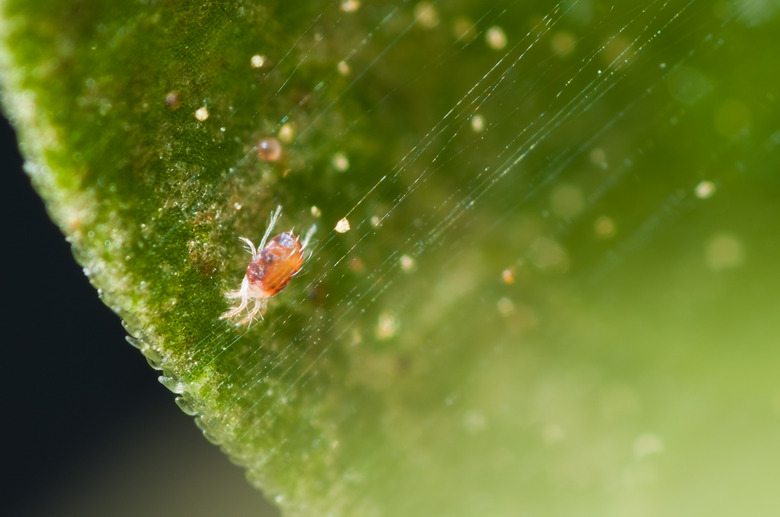How To Get Rid Of The Little Red Spider Mites On Concrete
Mites are unfortunately common in home gardens. They're destructive pests that suck the juices from your favorite ornamental plants, fruit trees, and veggies. These tiny pests are not true insects — they're actually in the arachnid category with spiders and scorpions.
For example, red spider mites are listed in the Tetranychus genus, while their relatives, clover mites, are classified in the genus Bryobia. They are both tiny and difficult to distinguish from each other. They cause similar damage and require similar treatment on plants and on concrete. Read on to find out how to deal with them if you suspect they're damaging your plant.
Spider Mites vs. Clover Mites
Spider Mites vs. Clover Mites
Both red spider mites and clover mites, when adults, are red-brown and very tiny. Spider mites are about 1/50 of an inch long, while clover mites are 1/30 of an inch. You probably can't make out a mite's eight legs without a magnifying glass, but that's why they are in the spider class rather than the insect category. The best way to distinguish clover mites is to look for two front legs that are much longer than the others. These are often mistaken for antenna.
Mites live in groups on the underside of leaves, using their piercing/sucking mouth parts to bite into and ingest plant fluids. Over time, the leaves stipple, curl, die, and fall. With spider mites, you may see fine webbing under the leaves or joining the leaf and the stem. With clover mites, if you smash one, it leaves a red stain that looks like blood. Another difference: spider mites love hot weather, while clover mites prefer cool weather.
Mites on Concrete
Mites on Concrete
Female spider mites begin to produce eggs after mating, and can have as many as 300 over a fortnight. Clover mites lay less, producing only about 70 eggs, but these pests are parthenogenetic, meaning that eggs do not need to be fertilized. All clover mites are female and all of the eggs will hatch, so the population can increase quickly.
Mite species often lay eggs on the leaves and bark of host plants, and the eggs overwinter there. Spider mites like dusty areas, so may congregate on dusty sidewalks near your garden plants. And sometimes clover mites lay eggs in protected areas rather than on the loose bark of trees. For example, sometimes the females lay their eggs in cracks in concrete or under shingles.
Preventing a Mite Infection
Preventing a Mite Infection
Like many plant problems, a mite infection can often be prevented by good cultural care and vigilance. We asked for suggestions from Monique Young, Vice President of the Board of Directors of the Ruth Bancroft Garden & Nursery in Walnut Creek, California, as well as an avid gardener in her own right. She warns that you can introduce mites into your garden by bringing in plants or even pots that have mites or eggs on them.
"Take a close look at new plants to see if the leaves are stippled or there are other signs of pests," Young advises. "Don't bring them into your garden if you suspect mites." As for pots, Young suggests washing them well and even sterilizing them before reusing.
Mites have more of a chance of infesting a garden or orchard if the plants are water-stressed. Water your plants regularly and well. Dusty conditions can also lead to mite infestations. Water is the trick here too. Water down the pathways in the backyard when you water your plants. Also, give the fruit trees a shower with a hard spray of water from time to time, even before you notice mite issues. That may be enough to prevent an infestation or get rid of a small one.
Managing a Mite Infection
Managing a Mite Infection
The first line of defense against mite infections should always be water. In many instances, it is possible to wash mites off fruit trees, ornamentals, and plants in the vegetable garden with a strong hose spray. If you see mites on concrete, a hose can also dislodge them. But if that doesn't work, there are additional alternatives.
Monique Young's practice, when facing a mite infestation, is to follow the integrated pest management guidelines published by the University of California, and this is what she recommends to readers. The most important thing to avoid, she says, is the application of broad-spectrum insecticide treatments for other pests. These pesticides often kill off the natural predators of mites (like predatory mites, six-spotted thrips, spider mite destroyer lady beetles, and pirate bugs) which increases the possibility of a large mite population.
If additional treatment is required, Young uses insecticidal soap or plant-based oils recommended by the University of California, like neem, canola, or cottonseed oil. Horticultural oils or plant extracts made up into organic acaricides are also suggested, she says, like clove, mint, or cinnamon oil. These must make contact with the mites in order to get rid of them, so spray thoroughly on both sides of each leaf.
Although these products are not toxic, you should exercise care when you apply them. "Don't use any of these products on a water-stressed plant or in hot weather," Young says. She also recommends that a gardener test out a product on a portion of an infected plant's foliage before making a general application. On the other hand, you shouldn't hesitate to apply insecticidal soap or horticultural oil to areas of concrete or cement if you see mites there. When the mites are dead, hose down the area.
